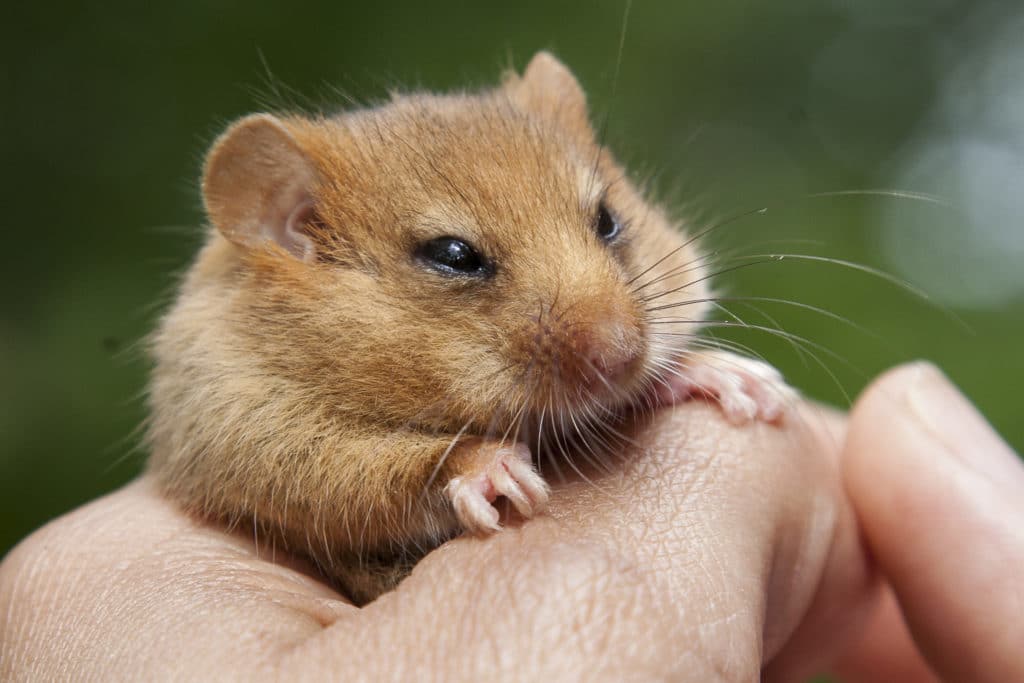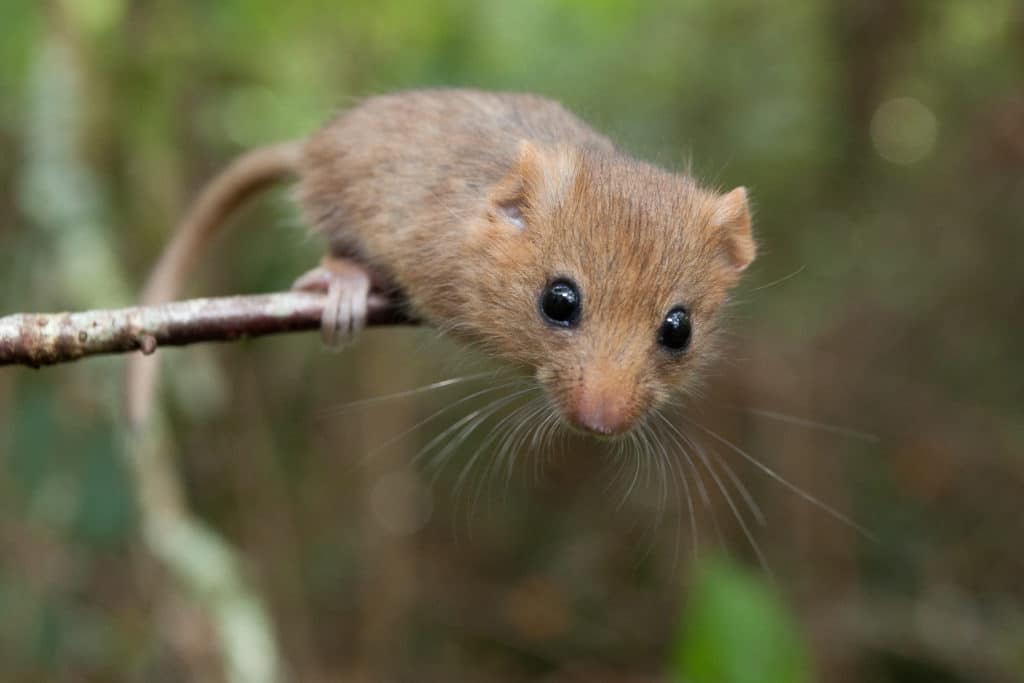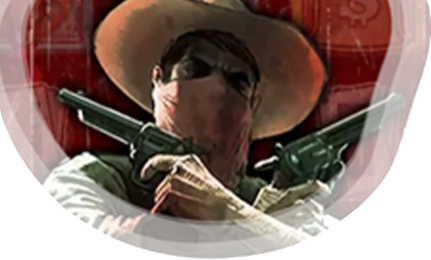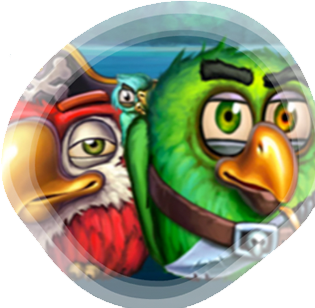October 18, 2020
Dormice: Adorable Representatives of the Ecosystem



PTES & Dormouse Conservation
If you’ve travelled through the British countryside you’ll notice it all looks very green. You might even think ‘Doesn't this look wonderful?’. The reality is, it's not as wonderful as it looks, it’s actually quite basic. In terms of the biodiversity and habitats it contains, it is becoming more and more simple...
We spoke to People's Trust for Endangered Species, an organization that has been standing up for wildlife all over the world for over 40 years now. The interview took place with Ian White, a passionate dormouse conservationist. It turns out this small, adorable creature proves to be particularly valuable in all kinds of conservation work.
Dormice are a key indicator of a high quality habitat as they have specific living conditions they can survive in. In other words, if there are dormice in a natural environment, it means there’s a broad range of other species there as well, which makes them really valuable.
Keeping dormice in mind as an example for trends in other species, it’s significant that the UK has lost 50% of dormice in the last 20 years. With weather conditions changing throughout the year, and over time in general, dormice need to be able to hibernate, breed and move. These activities are becoming increasingly difficult for them, as for other species, due to diminishing woodlands, habitat fragmentation and climate change. Although the situation for dormice is particularly bad in the UK, it’s likely to be similar across Europe.
PTES monitors dormice across the UK. They run programs to help others manage their land, to re-establish dormice where they’ve become extinct and to improve habitat links. Over the next decade they are hoping to see dormouse decline stabilise and eventually populations to increase again.
Internationally PTES fund projects concerning any species at risk, that they believe can be impactful. Apart from offering funding to NGOs for conservation projects they offer internships and funding to young people coming out of university, wanting to start their career as conservationists. They also have ample volunteering opportunities that give people the chance to get out and, under the guidance of specialists and enthusiasts, bring back biodiversity and rebuild a connection with the countryside that supports us.
If you want to get involved, visit https://ptes.org/get-involved/. The organisation has seen an increased interest from people, who are more aware of their environment as a result of having to stay home due to the pandemic, and are hoping this will continue so why not join them today?
Great.com is the world’s first online casino affiliate to donate 100% of its revenue. Our mission is to bring the most good in the world, and we believe we can have maximal net positive impact by operating within the New Jersey and Sweden gambling market. We’re currently focused on mitigating the global climate crisis and have contributed more than $1.3 million to various environmental charities.
[00:00:00]
Every day you and I get bombarded with negative news. And just like our bodies, become what we eat, our minds become the information that we consume. If you want to stay positive, it’s so important that you also listen to stories that inspire you and uplift you. In this podcast we interview leading experts dedicated to solving the world’s most pressing problems. And if you stick around, I promise you will not only be as informed as if you watched the news, you will be uplifted, inspired, and have more positive energy in your life. Welcome to Great.com Talks With.
[00:00:44]
Welcome today, great dotcom talks with PTES.org, which stands for the People’s Trust for Endangered Species. And this is an organization that has been standing up for wildlife all over the UK and in the rest of the world as well. For over 40 years now, and with the help of scientists, conservation specialists, and agriculture conservative. Oh, my God, Alewife is going to have to help me with this landowner’s and the general public. They have been working to protect UK delicately balanced ecosystems by protecting the most endangered species. And I’m here with Ian White, who is a dormouse and training officer for the organisation. And this is a very it’s a specific type of rodent that I don’t know very much about, to be honest. So I am very interested to talk with someone that has a specific interest in an animal I know very little about. So I am welcome to our podcast. Thank you. So how would you describe your organisation with someone that might not be so familiar with your calls or the challenges you’re facing for the wildlife in the UK?
[00:02:00]
Well, I think in your introduction, you kind of looked or implied that we are very much UK based and I think most of the time we haven’t been more internationally based or supported international projects. So over the last 40 years, we’ve funded a range of international projects that are predominately looking at species of conservation concern where we feel we can make a difference. So, for example, one we’re still involved with at the moment, we’re looking at or helping conserve John Waters in Peru, slow loris in Java, lines in Tanzania and leopards in Iran. So there’s a range of projects and we work with overseas partners to try and deliver conservation benefits to those species. I suppose it’s only been in the last 20 years or so. We’ve started focusing, not focusing, really, but actually involving more UK species. So we’ve been the key conservation charity in the UK for dormice for the last 20 years, probably for the last five or six years, we’ve been doing a lot more work on the European hedgehogs and also we’ve put a lot of work on waterfowl in the UK as well. So it’s not like we shift our focus. We just kind of added to what we do. So as well as doing international projects now, we also do national ones as well.
[00:03:16]
So help me understand how this started. Well, who started organization? Did you begin with just one pair of spaces and you said, no, we want to protect these as well and this as well and expanded all over the world?
[00:03:30]
I think we started off pretty much as an international charity. So we were funding work. We initially started off by taking money in and seeing where we could help species of conservation concern internationally. And that’s just kind of slowly developed and grown, I have to say. And also, I suppose in many ways quite fortunate because we haven’t kind of set our sights and said, well, we’ll only fund projects. Mamool projects were only funded projects, only unfinished projects. We can pretty much fund any species of conservation concern internationally, which means we have great flexibility, which is quite exciting.
[00:04:09]
Right. And so and you’re active in the U.K. and I read on your website that two thirds of the wildlife species has declined in the UK over the last 50 years. How would you say the situation for wildlife is in the UK compared to your international projects?
[00:04:27]
Well, certainly recent information has come out looking at the global loss of biodiversity or the potential loss of biodiversity around the world and certainly in the U.K., we don’t do particularly well in terms of conserving what we have. We’re not doing a great job. And I have to say, I almost appear from a personal point of view of being involved with PTSD 2006. So I’ve been involved in this for quite a while. And it does seem from the government point of view, the government has set guidelines as to how they want to try and improve biodiversity. But the goals kind of keep changing and keep moving and keep shifting with the overall consequence of that is generally decline, still seem to be persistent, and we still seem to see a loss of our wildlife, both in numbers and kind of diversity in the UK. So there’s still a lot of work needed doing here.
[00:05:19]
It’s a big challenge for sure. So what is the approach of Peter E.S.? What are your main strategies for preventing wildlife loss?
[00:05:30]
I think the last two things, really, one is it works both nationally and internationally is from that you have to identify people that are close to the project, so close to the species and the people, because conservation as much is as much about people as it is about the large, exciting animals or even the small, unexciting animals is as much about people. You have to find people that are keen, enthusiastic, able to engage with others. So a lot of the projects as a fund is local. People at a local level are passionate about a species that they can get. They can then enthuse others to try and help conserve the species. And in many ways, that’s also what we do in the UK. An awful lot of my work is basically talking to volunteers, to landowners, to people who might be able to assist, because at the end of the day, I’m only one person trying to help conserve a species in the UK. I can’t really do it alone. So the only way we can do it is by involving other organisations, other individuals, by talking to them to try and enthuse them as well, to try to help species.
[00:06:42]
Right. And I think this is an interesting time then to switch in and talk more about what you do, because I think your passion for preserving dormice, Miles, might be a good example of how pets as a whole works. So how does someone go about saving these mice?
[00:07:04]
My words today?
[00:07:10]
Well, dormice, I’ll give you a bit of a background on dormice first, which might help. So the one from the dormice says people often confuse mice and rats, which the public often perceive as being a pest or nuisance species or can be a pest or nuisance species. So there’s quite a lot of species of mice and rats throughout the world. There’s a lot less visita mice. So these dormice are much more specialised species. There’s only about twenty six species worldwide. There’s quite a small group and they tend to be habitat specialists. We have a native species in the UK called hazel dormice. So this is a species of ancient Woodman’s old hedgerows and scrub basically. So they, they, they it’s kind of been here. It’s a native species that they came in with the last ice age. But they always live at low densities because they have quader they breed quite slowly and they hibernate over winter. So that reduces the breeding, the breeding potential. So this is a species that lives at very low densities in terms of the value of the species and doesn’t really have one in terms of the likes of rabbits or even edible dormice is actually used to be a food source in the past. But Hazeldene mice don’t. But what they do have now is if it’s if an area or a habitat is good for hazel gall mice, you have hazel dormice in that area. It’s likely to be good for a broad range of other species as well. So we can use hazel. Biomass is a really good key indicator species. If we’ve got hazel dormice in a woodland or in a hedgerow, it means you’ve got a broad range of other species as well, which makes it really, really valuable.
[00:08:47]
So how do we go about kind of protecting a species, looking after species? Well, with some of the other things is really the decline of heisel dormice are three reasons, really. One is management of where they live. So management of woodlands. The other is the isolation of woodlands in the landscape. So habitat fragmentation, dormice need to have a tree and shrub layer to kind of move around and get around the countryside. And the third, which is tricky to do anything about, is the impacts of climate change. So three things: woodland or lack of appropriate woodland management, habitat fragmentation and climate change are all impacting dormice declines in the UK. I have to say, it’s not just in the UK. This is a European species. My suspicion is that actually similar things are probably happening in mainland Europe as well. The difference, again, within the UK is the UK is very much at the edge of the range for the normal’s not because of where it lies geographically, but because of the maritime climate we have in this country, is because we can have quite wet winters, we can have quite wet springs, and that impacts on dormi survival hibernating and almost also DOMAs breeding as well, whereas you tend not to have those extremes in mainland Europe. So we are right to the edge of the normal range. But nonetheless, they have been here the last 10000 years, so we should do our very best to try and make sure populations are maintained. So what do we do? Well, we have a monitoring program that’s been running for 30 years now.
[00:10:23]
So we have a lot of volunteers going out, looking at dormice in nest boxes and counting. Let us know. How the doorman’s population is faring and it’s not doing very well since the year 2000, we’ve lost over half of our population in the UK. So dramatic declines in 20 years, we have lost half the UK’s dormice. So the monitor is important because it tells us what’s happened to the dormice population nationally, and then it means we can start to do something about it. So what we’ve looked to do about it, we’re not. We do it. The charity does own some land. It’s not huge amounts of land. We’re not a real land and landowner organisation. So you have to work with other people to provide guidance and help on how to best manage their land to try and improve things for dormice. Do must also become extinct in a number of areas of the UK and there’s been too much reintroduction program running since nineteen ninety three to see if we can restore dormice to those areas. So in terms of conservation is very much focused on trying to improve woodland management, to improve things, to try and re-establish dormice where they were known to have existed but don’t anymore, and also trying to improve habitat links and improve the connections to allow Dorman’s to disperse out into the wider landscape so that that will improve, should longer term, will improve local populations, will improve dispersal routes and also put them back on site where they once were.
[00:11:56]
Right.
[00:12:00]
Something I say is interesting, what you said is your assumption that a lot of people see dormouse mice as a rat or a regular mouse and see them as kind of this pest animal. So is that a hard hurdle to overcome? I guess if you want to protect wooded areas for an elephant or an animal. We have more connection to it’s got to be easier than trying to protect. I guess it’s a hard sell, right? Someone wants to build something and you want to preserve the wetlands for a rodent.
[00:12:36]
And it’s we’re very lucky with the allies because Domus are incredibly cute. So if people get to see a mouse and you can explain it to them as to that dilemma in terms of why this isn’t a mouse, why this species isn’t a problem, people are usually pretty sold on it. So I don’t really see it as a problem. I see it as an education or training opportunity to try and make sure that more people know that message, that this is not a pest species. It will never be a pest species. It is actually a really good indicator of very high quality habitat.
[00:13:17]
Right, and that’s the mindset shift, I guess, is very important and a good thing you got to speak about it in this podcast today. So help me understand from its points of view what would be a really great outcome for your work with dormice in the next 10 years?
[00:13:39]
Well, I suppose ultimately was to see the Dormouse decline in the UK that we know is occurring to see that initially stabilize and then actually start to increase again. But to say this just seeing the decline from the last 20 years is pretty dramatic, having lost 50 percent almost in the last 20 years. So to see that stabilize, stabilize over four or five years because dormice populations, like most normal populations, fluctuate annually. So you need to take an average over a number of years. So in your 10 year window in five years, that will be taken up by just looking at the average population. But I suppose ultimately I would feel we would succeed if Middlemiss point of view, if we start to see that that decline stabilised and then slowly start to improve over time.
[00:14:27]
Right. Yeah.
[00:14:30]
I’m really looking forward to today when I do interviews with nature organizations and people start saying, you know, what is actually turning around? We’re seeing the numbers that we see, the numbers go up. And I guess dormice is a very good indicator on how the ecosystem as a whole is doing.
[00:14:46]
It is. And I would agree with you. I also hope whilst the current pandemic has been tragic in many senses, one thing that we’ve kind of seen about it is because a lot of countries have been in kind of like a lock down.
[00:15:02]
Some people spend a lot of time at home. People I think are from a little bit more aware of their environment and the areas around them. And we’ve certainly had a number of calls in terms of coming in. I suppose people show a lot more interest in their wider environment as a consequence of being shut. They’ve been having to stay indoors because of the pandemic. So I hope that the people will start taking some more interest, I suppose, in the environment. And that is then reflected in our political masters that actually start doing something a bit more proactive in how we might alter change, improve things for both wildlife and the natural environment.
[00:15:42]
I really enjoy that. You see the benefits something like the pandemic can bring. And what you’re saying now is interesting to me. You’re talking about taking political action, but what else can someone do that is they want to do something to help protect the wildlife in the UK, for example?
[00:16:02]
Well, I say for Dormi Dormi specifically, it’s difficult because dormice is highly protected under various legislation. So they are a very protected animal and it makes it illegal to disturb.
[00:16:13]
So it’s very difficult for people to get involved immediately about what they can do. And again, it’s something I think we’re very lucky about in the UK is we have a large number of NGOs, non-governmental organisations and conservation charities where people can go and volunteer or they can go and help work outside under the guidance of those charities. And I think that’s that’s the we do have a very good volunteer and I think in the UK and there is a real opportunity for people to get out and do something and all that kind of help, because an awful lot of all one of the reasons the species are declining is actually the I suppose, almost the simplification of habitats. So many people driving around the British countryside will think it all looks very green. It looks very nice. Doesn’t this all look wonderful? And the reality is it’s not that wonderful. It’s actually quite simple in terms of a lot of the diversity and the habitats of is becoming more and more simple. So to actually go and volunteer with a conservation charity, kind of put something back in and try to help improve those habitats for the better is, I think, a pretty good thing for people to think.
[00:17:26]
I think so, too, and coming together with like minded people and doing something together that is positive for the environment, I guess, has a. Good effect for your overall well-being and how connected you feel to the environment as well.
[00:17:42]
Absolutely. I think one of the there’s a real issue in terms of people becoming less and less connected with the wider countryside. I mean, when I kind of think back to my childhood, I spent a lot of time on farms.
[00:18:02]
My wife, her father spent summer on a farm. And you can look now there are a lot of people involved in farming and actually involved in being outside in the environment. You look now with a lot of people living in cities, there seems just to be a real disconnect between a lot of people and the countryside that supports them.
[00:18:23]
No. I think so, too, and OK, so.
[00:18:29]
We talked about what someone can do to help dormice, but if someone wants to support PTSD as a whole, what can someone do to help or to get involved?
[00:18:42]
I suppose at the end of the day, two things, one is in terms of we’re obviously required on a voluntary give in to to basically support to allow us to support these projects so you can kind of go expose come to ways round is one is that these projects obviously require funding.
[00:18:59]
So it is actually supported with the donation to do what we do. The other is if people have a real passion for a species until there’s a problem, there is we are also grant giving organizations so they can actually come to us with a project to actually see if we are able to fund it. One of the things we do is I’m I’m particularly proud of, I must admit, is that we also support interns. So this is young people that have come through university college with a passion for conservation and keen to get into and move into the sector. We will often fund or we will fund a number of projects in the year to give them kind of the first step on the ladder of moving into or becoming a professional conservationist.
[00:19:43]
Wow. That’s a real exciting opportunity. Now, we have come up to the end of this interview. I thank you so much for taking the time to speak with Greater Icon today. Thank you very much. Thank you. And for you listening, if you enjoyed this conversation, I would like to help us out to spread these kinds of messages in some way. Something that we would really appreciate that you can do is to go into your podcast app and press the subscribe button that will greatly help us climb in different top lists and then more people can hear these kinds of messages. So thank you for listening and we’ll see you in the next episode.
END OF TRANSCRIPT



